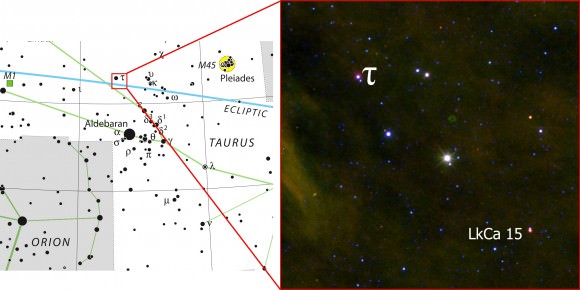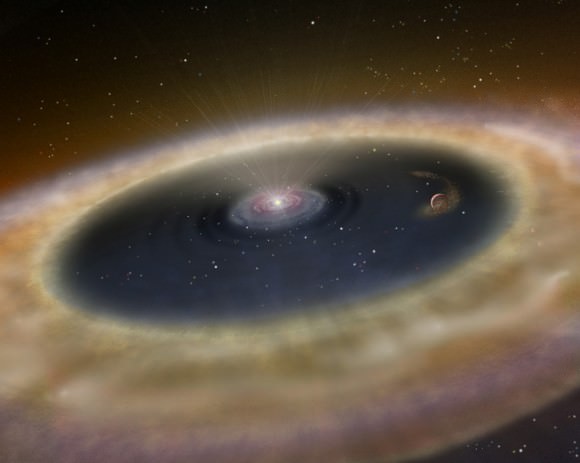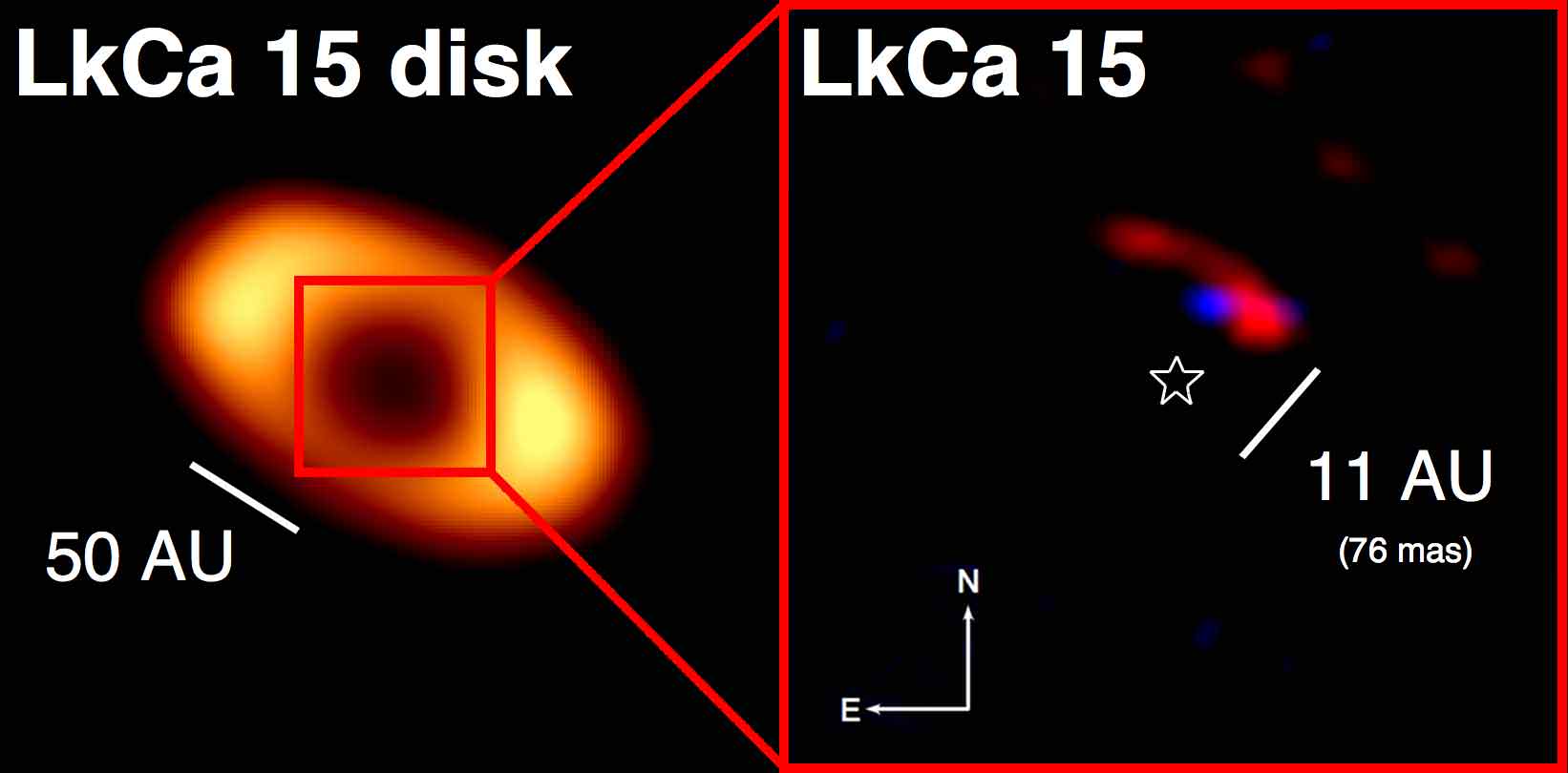[/caption]
Astronomers have taken a step closer to finding out how planetary systems form with the discovery of the ‘youngest’ planet ever found. LkCa 15 b is so young, it is still in the act of forming. This is the first direct image of a planet in the process of forming, and data indicates the planet is still being pieced together by gas and dust falling into its clutches from a cooler envelope that surrounds it.
The hot protoplanet orbits a star which possesses a mass comparable to our Sun, and is the youngest planetary system ever to be identified, with LkCa 15 aged at 2 million years, “We really have the age of the star and not the planet,” said Michael Ireland, a lecturer in astrophotonics at the Australian Astronomical Observatory. “The age of the star was determined by a great many people studying the gravitational contraction of both LkCa 15 and all of the other stars in the Taurus star forming region, which formed at nearly the same time.”
The observations were made by astronomers from the University of Hawaii and the Australian Astronomical Observatory using the keen eyesight of the twin 10-metre Keck telescopes located on the summit of Hawaii’s dormant Mauna Kea volcano.
For decades, astronomers have been aware that many young stars that pepper the Universe are shrouded by clouds of gas and dust. And since this realization they have enlisted the help of powerful infrared space observatories such as NASA’s Spitzer Space Telescope to peer into dusty cosmic regions that are hidden from optical telescopes.
Until now scientists had not been lucky enough to capture observations of new planets forming around these young stars, but thanks to the trickery of adaptive optics combined with ‘aperture mask interferometry’ that allows astronomers to resolve discs of dust around stars without the hindrance of dazzling starlight, imaging LkCa 15 b became possible. “It’s like we have an array of small mirrors,” said Adam Kraus of the University of Hawaii’s Institute for Astronomy. “We can manipulate the light and cancel out distortions.”

The astronomers have made the clever technique operable since 2008, which allowed them to search for gaps between stars and their protoplanetary dust discs where they figured planets are most likely to be lurking. In 2009 they were rewarded for their efforts as LkCa 15 b presented itself hugging its star, still bright from the energy of its formation. “LkCa 15 was only our second target and we immediately knew we were seeing something new,” said Kraus. “We could see a faint point source near the star, so thinking it might be a Jupiter-like planet we went back a year later to get more data.”
This hot, young world provides a view of the hellish birth of nascent planets.
“The protoplanet is heated up by its gravitational contraction energy,” said Ireland. “Gravitational potential energy is enough to make a truck’s brakes really hot when it goes down a mountain too fast. The potential energy of an entire planet being dropped onto itself is enough to make it glow red hot for millions of years. The planet is more than 1000 degrees Celsius – measuring its temperature more accurately is one of our goals next year. The dust and gas is mostly heated by the radiation field of the star and planet, and in equilibrium, reaches a temperature of less than 100 kelvins [-170 degrees Celsius].”
However, as the young planet pulls in more gas and dust onto itself, the astronomers can only guess as to how big this distant world could get. “The large outer disc around LkCa 15 still has about 55 Jupiter masses of material left in it,” said Ireland. “It is very difficult to estimate just how much of this material could end up on LkCa 15 b. If the orbit is nearly circular, and there is only one planet, then I believe that only a very small fraction of this matter could end up as part of LkCa 15 b. If I had to guess, I’d say around 10 times the mass of Jupiter for a final mass, with a little orbital migration to a closer orbit. However, we’ll get a better idea on this over the coming years with new theoretical models and after we see more of the orbit of the planet.”
The team’s paper can be found here.



I have to gush about this again: I never thought I would see a planet under formation!
That the T Tauri star is also forming (not yet fusing hydrogen) adds another degree of awesome.
This is incredible. It seems to me that we are finding incredibly interesting things about exo-planets every week these days! Exciting times. To be able to see such a baby planet is truly incredible.
What I don’t understand is how planets can form at all. Doesn’t the radiation from the forming sun blow all that gas/dust away from it?
Sort of.
A perhaps prevailing theory, at least according to my astrobiology text books, is the “X wind” which blow out stuff at the poles of a forming star.
(The “usual” jets from disks are seen here too. The “X” refers to the geometric configuration of the magnetic field, see for example p41 here. As you can see a result is that some material go up one leg of the X, some the other. Don’t tell the EM magical thinkers. =D)
Most of the wind falls back to the disk (or star), so there is a lot of mixing going on, explaining why comets have once heated silicate stuff in their innards.
My impression is that the dominant dust blow out occurs after the star ignites, often erratically making massive coronal mass ejections to boot until it settles down. The planets have cleared very little stuff out when they form, they may eject more stuff when giants migrate, but AFAIK most blows away at that time.
At the rate we are discovering we are at the verge to find alien life forms. Probably bacteria.
That means god doesn’t form planets? lol